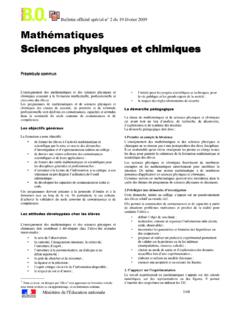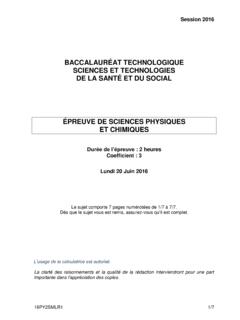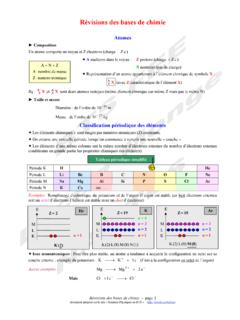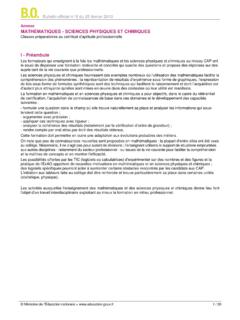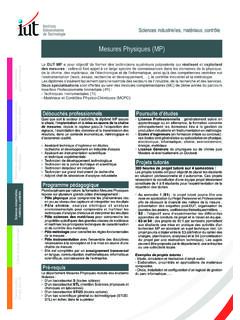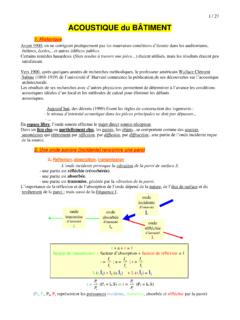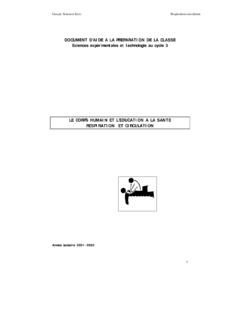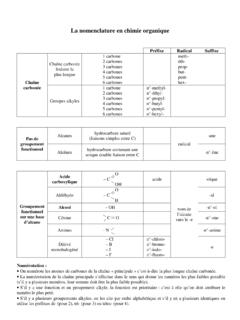Transcription of SCIENCES DES MATÉRIAUX 1/7 1 2 3 4 5 6 7 8 9 10 11 M
1 SCIENCES DES MAT RIAUX 1/7. 1. 2. 3. 4. 5. 6. 7. 8. 9. 10. 11. MEMENTO SCIENCES DES MAT RIAUX M18. M. SCIENCES DES MAT RIAUX 2/7. 1. STRUCTURES CRISTALLOGRAPHIQUES ET PROPRIETES PHYSIQUES. 2. Coeficient de Capacit Capacit . Masse volumique Temp rature Grandeur Dilatation Calorifique Calorifique r ( ) de fusion ( C). (10-6 . C-1 ) ( -1 . C-1 ) ( -1 . C-1 ). 3 METAUX. Aluminium Al 24 900 247. Argent Ag 19 235 428. B ryllium Be 1278 12 2422 160. Cadmium Cd 321 29 230. 4 Chrome Cr 1890 455. Colbalt Co 1495 418 95. Cuivre Cu 1083 386 398. Etain Sn 23. 5 Fer Fe Lithium Li 1535 448 80.
2 179 56 2980. Magn sium Mg 651 26 1012 160. Mangan se Mn 1244 23. Molybd ne Mo 2610 247. 6 Nickel Ni 1453 13 443 90. Niobium Nb 2468 Or Au 1063 14 130 315. Platine Pt 1769 132. 7 Plomb Pb 29 33. Tantale Ta 2996 Titane Ti 1675 524 Tungst ne W 3410 142 178. Uranium U 1137. 8 Vanadium V 1890. Zinc Zn 388. Zirconium Zr 1852 316. 9 COVALENTS. Carbone C diam > 3500 510 70. Silicium Si 1410 879. Carbure Si SiC 2300 90. 10 OXYDES. Alumine Al2O3 2050 775 30. Silice SiO 2 740 2. Oxyde de 2580. calcium CaO. 11 Magn sie MgO 2850 940 38. Nutile TiO 2 1630-1850. M MEMENTO SCIENCES DES MAT RIAUX M19.
3 SCIENCES DES MAT RIAUX 3/7. 1. Coeficient de Capacit Capacit . Masse volumique Temp rature Grandeur r ( ) de fusion ( C). Dilatation (10-6 . C-1 ). Calorifique ( -1 . C-1 ). Calorifique ( -1 . C-1 ) 2. POLYMERES. Poly thyl ne Basse densit 98-115 100-220 2200 Haute densit 130-137 60-110 2100 Polypropyl ne 170 80-100 1880 3. Polychlorure de 160 50-100 Vynil (PVC). Polystyr ne Tg : 74-105 50-83 1360 PMMA Tg : 85-105 50-90 1500 4. Epoxy Tg : 370-390 55-90 1800 PROPRIETES MECANIQUES ( 20 C). Mat riaux Module d' lasticit . (GPa). Coefficient de Poisson Limite d' lasticit . R0,2 (MPA).
4 R sistance la traction Rm (MPA). 5. METAUX. Aluminium 70 40 80. Cobalt 210 300 800. Cuivre 120 60 200 6. Fer 210 50 200. Magn sium 45 40 160. Molybd ne 215 565 655. Nickel Plomb 210 60 300 7. 17 11 14. Titane 110 170 240. Tungst ne 410 1000 1510. Zinc 105 30-40 120. ALLIAGES METALLIQUES. 8. Aciers doux au 210 220 430. carbone Aciers au 210 250-1300 500-1800. carbone (tremp ). Aciers 190-210 240-400 450-800 9. inoxydables Fonte GS 150 280-630 380-840. Alliage d'Al 70-80 50-600 120-700. Alliage de cobalt Alliage de cuivre 200-250 300-2000 800-2500. 10. 120-150 100-900 220-1000. Bronze 110 120-600 250-700.
5 Alliage de Mg 45 110-280 160-350. Alliage de nickel 130-230 200-1600 400-2000. Alliage de titane 80-130 250-1200 300-1300 11. Alliage de zinc 105 250-400 280-425. MEMENTO SCIENCES DES MAT RIAUX M20. M. SCIENCES DES MAT RIAUX 4/7. 1. Module d' lasticit Limite d' lasticit R sistance la Mat riaux Coefficient de Poisson 2 (GPa) R0,2 (MPA) traction Rm (MPA). POLYMERES. Poly thyl ne Basse densit 6-20 20. Haute densit 1 20-30 35. 3 Polypropyl ne 20-35 35. Polychlorure de 45-50. Vynil (PVC). Polystyr ne 35-70 40-70. 4 PMMA 60-110 110. Epoxy 2-5 30-100 30-120. FIBRES. Carbure de 480 2300.
6 5 silicium SiC. Carbone 150-500 1500-3500. Verre 76 2000-3500. Kevlar 60-130 2700-3600. 6 CERAMIQUES (fritt es). Alumine (Al2O3) 390 275-550 3000. B ton 40-50 20-30 50. Diamant 1000 7000. Magn sie 210 105 3000. 7 Silice (SiO2). (quartz) 54 110 1200. (verre) 70 70 700. Carbure de Si 450 450-520 1000. 8 Zircone (ZrO2) 200 138-240 2000. COMPOSITES. B ton arm 40-50 410. Bois (fibres //). 9 (fibres ). 5-15. 30-180. 1-10. 10-60. 2-10. Polym res et 50-200 1000-2000. fibres de carbone 10. 11. M MEMENTO SCIENCES DES MAT RIAUX M21. SCIENCES DES MAT RIAUX 5/7. 1. Aciers d'usage g n ral D signation A37 A42 A47 A50 A60 A70 A85.
7 Fer de Rm r sistance max la 36 41 46 49 59 69 85 2. carbone traction da/mm 41 49 56 59 71 83 95. A 50 2. Classe Rm Qualit . Aciers non alli s pour XC18 XC38 XC48 XC68 XC100 3. traitements D signation thermiques Rm r sistance max la 36 41 46 49 59 71. X C 18. traction da/mm 41 49 56 59. Classe de C 4. D signation selon aptitude E 20 48 M. E : classe de l'acier 20 : charge limite d' lasticit 48 : charge maxi l'extension M : utilisation en moulage 5. Ou alors S : soudable TS : trempe superficielle DF : d formable froid Aciers alli s 6. El ments d'addition : - chrome (C)* - cobalt (K) - magn sium (G) - molybd ne (D) - nickel (N).
8 - plomb (P) - tungst ne (T) - vanadium (V) - silicium (S). 7. * symboles m tallurgiques Faiblement alli s : la teneur de chaque l ment d'addition < 5% en masse Exemple : 8. Teneur en carbone El ments d'addition en ordre d croissant 35 N CD 4 Teneur en l ments additionnels, Nombre multipli par 4 pour C, K, M, N ,S. et par 10 pour les autres l ments 9. de carbone + 1% de N + C (chrome) < 1% + D<C. Fortement alli s : la teneur de chaque l ment d'addition > 5% en masse 10. Exemple : Classe de l'acir fortement alli . Z 6 CN 18-09. d carbone + 18% de C + 9% de N 11. MEMENTO SCIENCES DES MAT RIAUX M22.
9 M. SCIENCES DES MAT RIAUX 6/7. 1. FONTES. 2 D finition : Produits ferreux + ( 5% d carbone). D signation : Ft 25 (Ft : fonte grise non alli e / 25 : r sistance minimale la traction). Exemple : FGS 400 12 FGS : fonte graphite sph ro dale 3 400 : Rm traction 400 N/mm . 12 : allongement A en % (12%). Fontes Nuances Ft 10 Ft 15 Ft 20 Ft 25 Ft 30 Ft 35 Ft 40. grises non alli es Rm 10 15 20 25 30 35 40. 4 daN/mm . Nuances MB35-7 MB40-10 MN35-10 MN38-18 MP50-5 MP60-3 MP70-2. Fontes Rm 34 39 34 37 49 59 69. mall ables daN/mm . A% 7 10 10 18 5 3 2. 5 Nuances 370-17 400-12 500-7 600-3 700-2 800-2.
10 Fontes FGS. graphite Rm 370 400 500 600 700 800. sph ro dal daN/mm . A% 17 12 7 3 2 2. 6 CUIVRE ET ALLIAGES DE CUIVRE. BRONZE. Cu + Sn + autres l ments Zn, P, Pb 7 Exemple Rm N/mm Applications D signation Cu Sn5 Zn4 450 Tous usages Cu Sn5 Zn Cu Sn12 Zn1 230 Coussinets Cuivre +. Cu Sn7 Pb6 Zn4 220 Moulages Etain 5% +. Cu Sn9 P 550 Frottement Zinc < 1%. 8 LAITON. Cu + Zn + autres l ments Al, P, Pb Exemple Rm N/mm Applications D signation Cu Zn35 180 Robinetterie Cu Zn39 Pb2. 9 Cu Zn40 340 Pompes Cuivre +. Cu Zn33 300 Emboutissage Zinc 39% +. Cu Zn39 Pb2 400 d colletage Plomb 2%.

